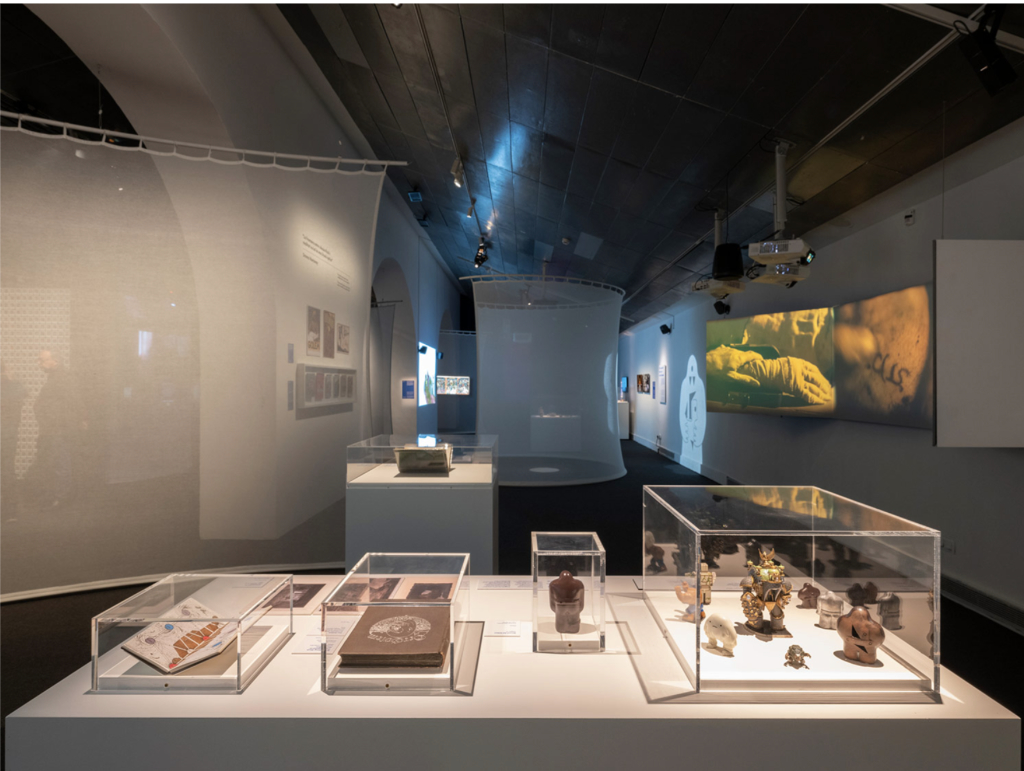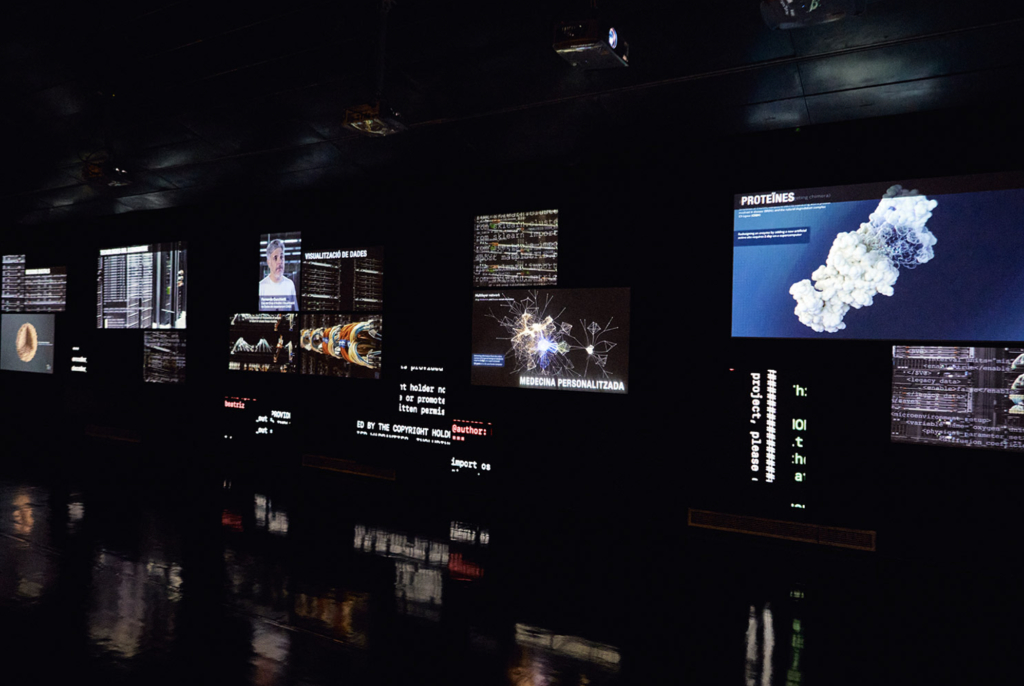Text by Irem Erkin

Lluís Nacenta is a curator, writer, musician, and researcher working in the confluence of music, art, technology, and science. He holds a degree in Mathematics, an advanced degree in Piano, a Master’s degree in Comparative Studies in Literature, Art, and Philosophy, and a doctorate in Humanities focusing on musical repetition. From 2015 to 2017, he was the Head of Masters and Postgraduates at EINA (University Centre of Design and Art) in Barcelona. Subsequently, he served as Director of HANGAR (Centre for Production and Research in Visual Arts) from 2018 to 2021. He is the local curator for AI: Artificial Intelligence, an exhibition on the history, functioning, creative possibilities, and ethical and legislative challenges of artificial intelligence today, held at the CCCB from October 2023 to March 2024.
The exhibition explores the experiments with AI, identifies its risks, discovers scientific and artistic innovations, and examines a decisive technology for the future of humankind. It sheds light on the idea that no technology has ever grown so fast and directly integrated into our lives. Artificial intelligence is both worrying and fascinating; it is a threat that generates opportunities. It has its detractors and defenders. The exhibition questions whether we can make decisions without its assistance in this context of public conversation and collective dependence on AI. It suggests that we should stop trying to understand artificial intelligence and start a debate about its development in the years ahead.
The exhibition looks at the role of artificial intelligence in everyday life, the opportunities it presents for scientific and biomedical research, the role of supercomputing as a major driving force, the present legislative situation, the risks of misinformation posed by its widespread use, and the racial and gender biases it can generate. The exhibition’s layout includes interactive artistic installations, a timeline with milestones, key works created using AI, expert testimonies, and newly created pieces. It explores the relationship between artificial intelligence and human creativity.


Regarding the relationship between artists and artificial intelligence, Lluís Nacenta observes two different approaches: the first is artists who use AI because it is the new trend in the art world. The second approach involves artists who courageously address AI, not taking for granted its ability to recognise patterns and regularities and to extrapolate based on what it knows but questioning the role of automation and extrapolation in the creative field. This is where exciting things happen, with artists simultaneously questioning the technology and the language of art.
Nacenta claims that the process of artificial intelligence shaping the language of art is ongoing, and we are still at a stable level of growth. What is emerging might be called the aesthetics of AI. His intuition is that it is an aesthetic of strangeness related to sensibility and questioning the regularities that AI is supposed to be very good at identifying and reproducing. Although it is still too early to say, Nacenta thinks this might be one of the curious end-products that working with AI can contribute to art, as AI is very good at categorising.
AI is particularly well-suited to disrupting the regularities of categorisation when engaging outstanding artists. In the interaction of AI and the artist in their creative process, Nacenta reveals that the relationship between artists and artificial intelligence in the creative process is debatable, questioning whether AI acts as a sophisticated tool rather than a collaborator. He believes that to be a collaborator, one must have autonomy.
From a curatorial standpoint, Nacenta examines two transformations in the art world. First is the notion of authorship, which he thinks contemporary art has been well-suited to address throughout the 20th century. Second is the relationship between reproductivity and automation. In that sense, he adds, If we speak strictly about the world of art and the context of art, I think AI is the most outstanding and recent chapter in the history of questioning authorship and making radical use of and problematising automation and reproductivity.
Thus, Nacenta finds it interesting because it is something the art world is already familiar with. The part that seems more attractive to him is the transformation of languages. It is true that AI is very good at extrapolating, creating a shift in artistic language whose outcome we do not exactly know.

Nacenta says that this most recent chapter on authorship, automation, and reproductivity greatly impacts the creative process, the language of art, and the audience. There is a comprehensible paranoia about artificial intelligence because we fail to properly relate to those technologies, which we should not be. Hence, we should be attentive and critical but not paranoid. He thinks paranoia is normal because the mainstream discourse repeatedly emphasises that we are not in control. Combined with how powerful this technology is and how good it is at making decisions, it’s scary. However, it is of vital importance to have political articulation. It depends on us, socially and politically, to decide what we should do with this technology.
From a strictly technical point of view, it is important to say that we are still in control. That’s just science fiction or wishful thinking from the side of tech companies. They think that what they are developing is so powerful that we might soon lose control. Nacenta disagrees that this is a realistic discourse. Tech companies are interested in this discourse because they are interested in the hype and the collective hallucination of how incredible it is. It’s incredible, but it’s just software.
So he underlines that art again has a key role, and we are still in charge. Let’s act accordingly. Let’s make use of political articulation. We need democracy more than ever. So please, let’s use democratic articulation to decide what aspects of our lives we want to apply AI to and in what aspects of our lives we want to avoid it. We shall consider that there is a long way to a ‘legal framework.’ We are in the far west of AI. We are colonising a new continent which has not yet been discovered. We just arrived there, and there is no law. It’s just a law of brute force. Paranoia comes from the fact that only a few companies are in charge. That’s the political problem, a problem of the concentration of capitalism. We all have the right to access the new frontier of human knowledge. Nacenta thinks that paranoia and the difficulties of regulation come from the fact that those tools are the private property of some people and not accessible to the public.
Discussing the new frontiers of human knowledge, the impact of artificial intelligence on art and human interactions, and the next chapters of artificial intelligence in creative processes, Nacenta raises a key, provoking question: What amount of human knowledge can AI really possess and relate to, thanks to its ability to process language in a sophisticated way?
We do not know, but we have to be very honest when addressing it. Humans’ essential aspect is creating things such as artificial intelligence and strange, radical, and frightening tools, such as fire… And we all know how that story goes.





